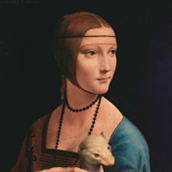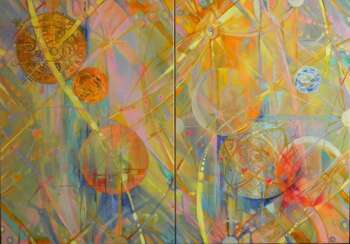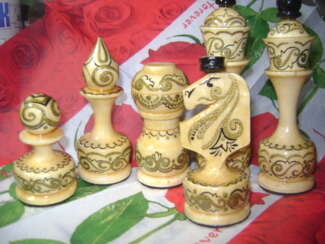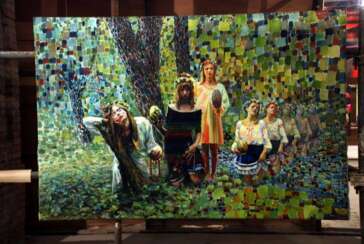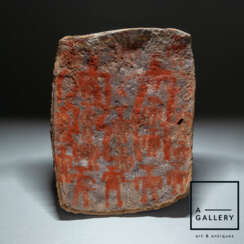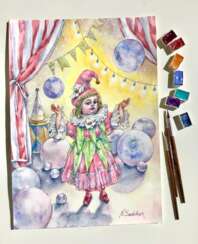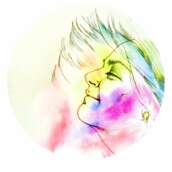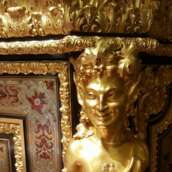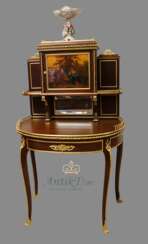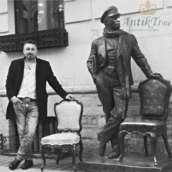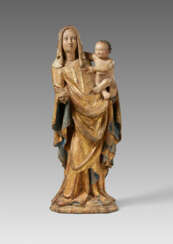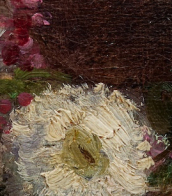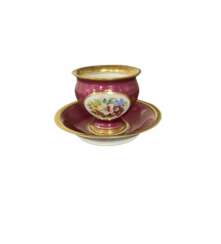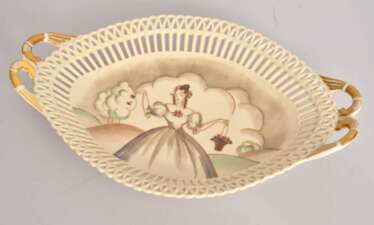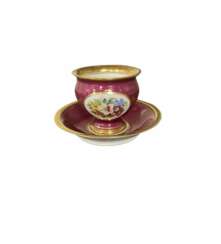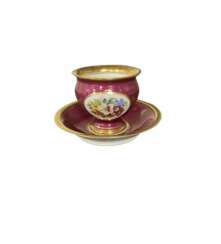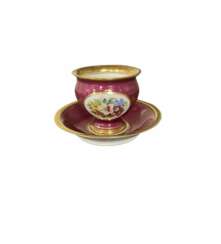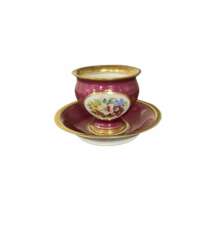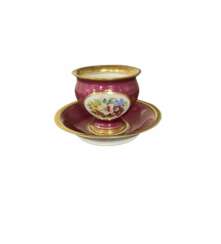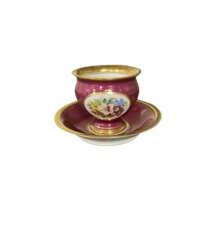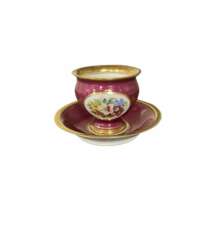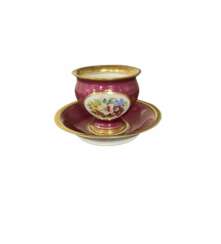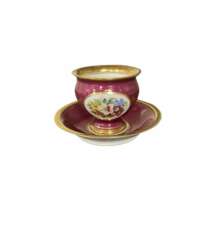42 Items by auctions and galleries:
расписанный
Полет на Марс
Yury Novikov (b. 1972)  Shop Novikov Yury
Shop Novikov Yury

Yury Novikov
01.10.1972
Ukraine
Привет, меня зовут Юрий Новиков, я профессиональный художник из Украины. Я предпочитаю работать с холстом и маслом, потому что это дает мне большую универсальность.Сейчас я работаю и живу в Харькове.

Artist shop
Novikov Yury
Ukraine
Number of products: 3
Шахматы в национальном стиле классические
Lyudmila Kumaneva (b. 1971)  Shop Kumaneva Lyudmila
Shop Kumaneva Lyudmila

Lyudmila Kumaneva
17.03.1971
Kyrgyzstan
Родилась и выросла в Кыргызстане... занимаюсь роспись уже 15 лет. Очень люблю свою страну, поэтому рисую природу на сувенирах...чтобы люди которые приезжают в нашу страну имели память виде сувенира..

Artist shop
Kumaneva Lyudmila
Kyrgyzstan
Number of products: 7
Альмаматерь всех индоевропейцев
Oleg Mingalov (b. 1959)  Shop Mingalov Oleg
Shop Mingalov Oleg

Oleg Mingalov
27.10.1959
Ukraine
Oleg Mingalev, artist
The artist, poet, playwright, theorist and designer of the postmodern trends in art: Narrativism (1977), Social Art (1979) Dualism (1982), Mystery Arts (1985), Neofuturism (1986) Video Poetry (1986), Ethno -modern (1997). Graduated from Kharkiv State Art School (1978) and Moscow Maxim Gorky Literary Institute (1985).
He lived and worked in UK, France, Holland, Italy. He has lectured at universities in London and Milan. And prepared art radio programs on topics for Russian service, BUSCH HOUSE (BBC), sold his works at auctions Phillips and Christies. Organizer and participant of international and national exhibitions. Name of the artist included in the Encyclopaedia Britannica art WHO'S WHO IN ART and Italian ANNUARIO. Author mystery-drama "Two Face" (1979), "Nebuchadnezzar" (1979), "Metro. Mysteries "(1980)," Munch "(2010)," Romeo and Juliet 2 "(2010)," Indigo "(2011), author of" Mysteries. Key to immortality "and “Manifesto on Dualism” (1982), and “Manifesto of Narrativism” (2014).

Artist shop
Mingalov Oleg
Ukraine
Number of products: 3
Забытые берега . Посвящение мирам Жюля Верна.
Igor Leontjev (b. 1957) 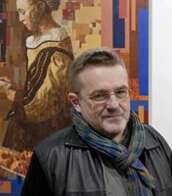 Shop Leontjev Igor
Shop Leontjev Igor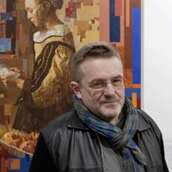

Igor Leontjev
12.10.1957
Russia
Born in 1957, Riga, Latvia.
Studied in the Jana Rozentala School of Art and in the Latvian Art Academy, also studied in private art studios such as V.Karkunov and A.Bykov.
The artist works in polystylism.
Participates in exhibitions since 1987.
Participant in the auction of Russian Art in "Dorotheum" Vienna, Austria.
Personal Exhibitions:
2018- Personal exhibition at gallery "Vinzavod", Moscow, Russia.
2017- Personal exhibition dedicated to the 60th anniversary of the artist, at gallery "Dar", Pskov, Russia.
2017- Personal exhibition dedicated to the 60th anniversary of the artist, at gallery "Stilgalerie", Vienna, Austria.
2016- Personal retrospective exhibition at "Antonia" gallery, Riga, Latvia.
2015- Exhibition in the Kunstraum Hubert Thurnhofer gallery, Vienna, Austria.
2013- Personal exhibition "Vienna the city of artists" gallery of Hubert Thurnhofer,
Vienna, Austria.
2009- Gallery "Antonia" Exhibition "Dream city" Riga, Latvia.
2002- "Painting" House of the Blackheads, Riga. (Booklet issued)
2000- Institute of Applied Psychology, Riga. (Booklet issued)
2001- "Atelier T" gallery, Vienna, Austria.
1998- Joint exhibition with N.Bessonova "Garant" Vienna, Austria.
1998- Gallery "Nelly", Riga, Latvia.
1998- Joint project with N.Bessonova "Birds and fish" gallery "Nelly", Riga, Latvia.
1997- "Dzintars" gallery, Riga, Latvia.
1997- Insurance company "New Reinsurance" gallery, Geneva, Switzerland.
1997- "Rigas Vini" gallery, Riga.
1996- "Sofia" gallery, Gelsenkirchen, Germany.
1991- Russian Cultural Foundation, gallery "Riga" Latvia.
Здесь подробнее :
https://igorleontiev.com/about
https://igorleontiev.com/
https://ru.wikipedia.org/wiki/%D0%9B%D0%B5%D0%BE%D0%BD%D1%82%D1%8C%D0%B5%D0%B2_%D0%98%D0%B3%D0%BE%D1%80%D1%8C_%D0%A4%D0%B5%D0%B4%D0%BE%D1%80%D0%BE%D0%B2%D0%B8%D1%87

Artist shop
Leontjev Igor
Russia
Number of products: 12
Голова льва,декор на стену,декор в детскую комнату
Natalia Dobriden (b. 1994)  Shop Dobriden Natalia
Shop Dobriden Natalia

Natalia Dobriden
14.04.1994
Ukraine
Здравствуйте!
Давайте знакомиться.Меня зовут Наталья. Я начинающий художник,любитель.
Пишу интерьерные картины ,а так же картины в детскую комнату на разные тематики.Большинство работ выполнены в абстрактном стиле .
Художественную школу не заканчивала,пишу от сердца и души .

Artist shop
Dobriden Natalia
Ukraine
Number of products: 8
Тукан живущий в старинном этюднике
Alexander Elizare (b. 1966) 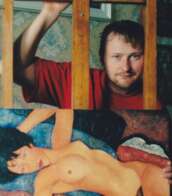 Shop Elizare Alexander
Shop Elizare Alexander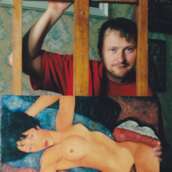

Alexander Elizare
30.08.1966
Russia
Мой отец был художником.
С пяти лет я начал рисовать восхищаясь картинами Ван Гога, Ренуара и даже Пикассо. Серьезно начал заниматься только после армии с 22 лет. Начались первые персональные выставки в Екатеринбурге, где я жил с родителями в то время. Живопись для меня это создание параллельного фантастичного мира добрых зверей, птиц и конечно людей. Много картин я посвящаю легендам Древней Греции. Множество картин посвящено женщине и любви. Я думаю, что любая картина должна нести глубокий позитивный заряд, предлагать радостную альтернативу серым будням.
Моим личным брендом в живописи и кинематографе является "Гранатовый Единорог", священный волшебный конь, бессмертный защитник зверей.
Моими самыми удачными картинами я считаю серию тропических птиц: Туканов, Африканских воронов, попугаев. Птицы для меня умнейшие ангелы леса, с ними интересней жить. Множество моих картин находится в частных коллекциях в России и Европе. В основном это тропические птицы, эротические сюжеты, пейзажи и цветочные натюрморты.
В последние десять лет я всерьез увлекся литературным творчеством. Пишу детективные романы, фантастику, и драму русской жизни. Хотя нужно признать, что написание романа, есть невероятно сложная попытка. Намного сложнее, чем написать картину или рисунок. Напишешь не интересно, читатель не станет тратить на твои мысли свое время.
Лучшие мои романы: "Аборигены Черного моря", "Жаркое лето месье Пергоко" и другие мои романы в мировых электронных библиотеках.
Член Союза Художников М.О. и Международного С.Х.
Покупать нужно только те картины, которые несут позитивную энергию и радость бытия. Все это видно на картине.
Всего я провел более 30 своих персональных выставок. Более 800 моих картин и иллюстраций находятся в частных коллекциях по всему миру, включая несколько ранних работ в США. Сейчас я не занимаюсь выставочной деятельностью. Рассказывать о своем творчестве можно прекрасно и здесь. Всех обнимаю. Ваш Александр Елизарэ

Artist shop
Elizare Alexander
Russia
Number of products: 62
"РАВНОДЕНСТВИЕ"
Yury Novikov (b. 1972)  Shop Novikov Yury
Shop Novikov Yury

Yury Novikov
01.10.1972
Ukraine
Привет, меня зовут Юрий Новиков, я профессиональный художник из Украины. Я предпочитаю работать с холстом и маслом, потому что это дает мне большую универсальность.Сейчас я работаю и живу в Харькове.

Artist shop
Novikov Yury
Ukraine
Number of products: 3
Долгожданная встреча
Aleksandr Bolkvadze (b. 1986)  Shop Bolkvadze Aleksandr
Shop Bolkvadze Aleksandr

Aleksandr Bolkvadze
07.11.1986
Russia
Болквадзе Александр Александрович
Дата рождения: 7.11.86
Контакты и социальные сети:
Instagram: @bolkvadzealeksandr
Telegram: @bolkvadzealeksandr
@bolkvadzealeksandr_art
E-mail: [email protected]
+79636522394
Родился в Москве.
Получил техническое образование, работал на военном авиационном заводе.
В 2005 начал самостоятельно изучать живопись. За 15 лет нарисовал более 100 картин маслом и акрилом, создал два десятка скульптур и инсталляций. Расписывал стены, мебель и декоративные предметы интерьера, а так же нарисовал сотни графических работ на бумаге и в Photoshop.
С 2020 постепенно отказываюсь от классических материалов и техник живописи, начинаю исследовать новые формы и медиумы. Часто использую в своих работах такие материалы как дерево, металл, войлок, шерсть, эмаль, зеркала, пластик, картон ручной отливки и некоторые смеси моего собственного изобретения.
2022-2023 создаю преимущественно объемные, фактурные инсталляции и скульптуры с использованием зеркал.
2024-2025 рисую фигуративные картины на волнообразных вогнутых круглых холстах собственного производства. Измененная геометрия плоскости холста создает дополнительную выразительность и сложные визуальные эффекты, позволяя по новому использовать традиционные техники живописи.
Важной частью моего творчества являются сопроводительные тексты к картинам. Именно тексты объединяют все мои работы в единую вселенную и связывают все сюжеты. Тексты дают мне возможность погрузиться внутрь картин и увидеть их глазами своих персонажей.
Выставки:
15.05.25- 18.05.25 - PORT ART FAIR Санкт-Петербург, Севкабель Порт, Кожевенная линия, 40, ЦЕХ, 1 этаж, Стенд G13 (Культурный центр «Артишок»)
6.02.25 - 7.04.25 - "Дай поцелую и все пройдет. Бабушке посвящается. Культурный центр «Артишок», Новослободская, 45Б (Кураторы: Ольга Шмуклер, Алина Вороная)
5.09.24 - 08.11.24 - "Выходя из вагона, не забывайте свои чувства!" Культурный центр «Артишок», Новослободская, 45Б (Куратор: Мария Дьякова)

Artist shop
Bolkvadze Aleksandr
Russia
Number of products: 63


